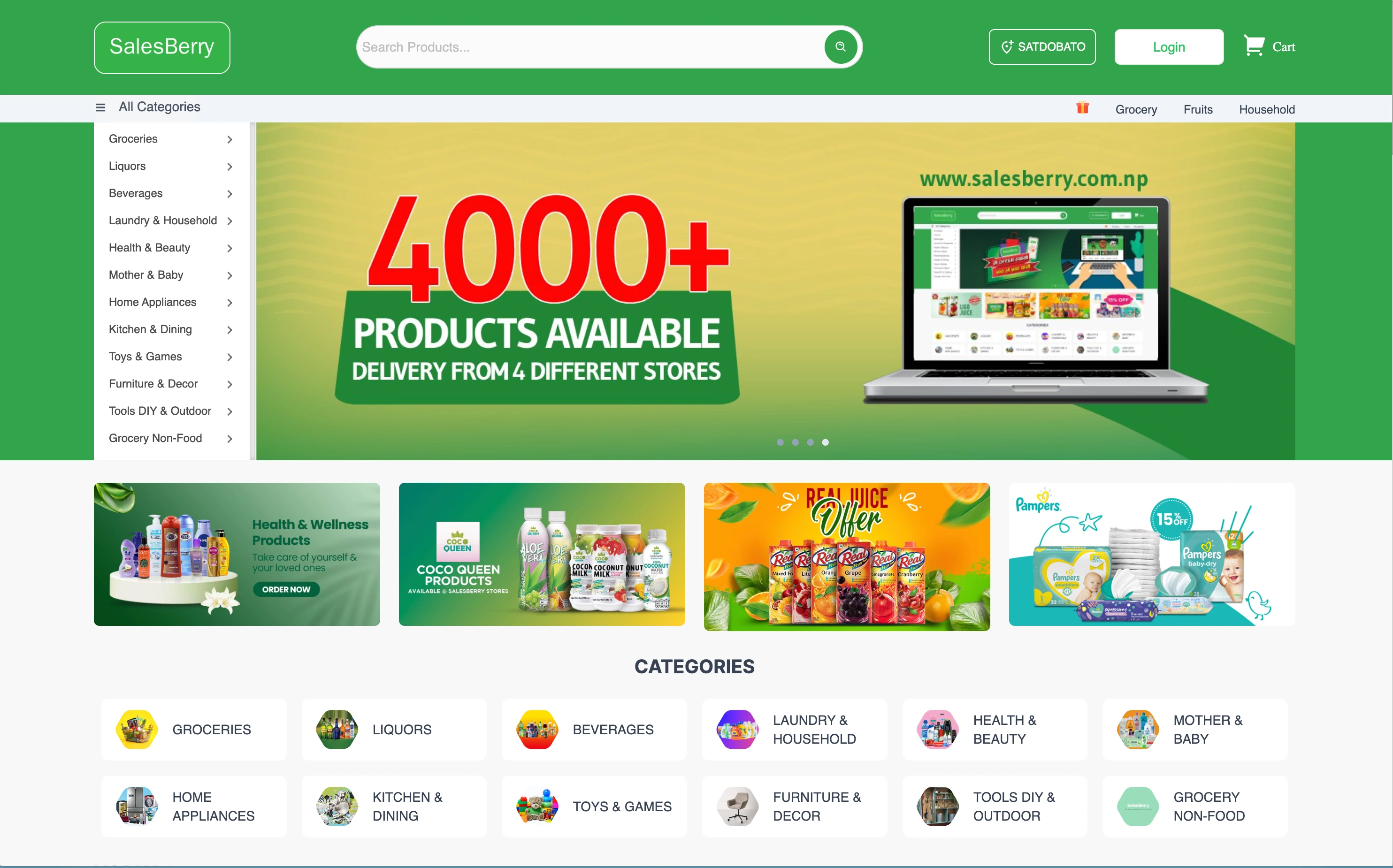SalesBerry - Ecommerce Engine

What is SalesBerry?
SalesBerry is a reputed chain of departmental stores across Nepal, offering its assortment of products through three store formats: Super Stores, Premium Stores, and Express Stores.
It claims to provide an unparalleled online shopping experience with 4 Super Stores, 8 Premium Stores, and 19 Express Stores, assuring shoppers of a good price challenge and customer service. Let the hassle-free and pleasant shopping experience begin with Salesberry, your ultimate destination in Nepal.
Key Features
1. Multi-Tenant Management with Admin Dashboards
Core Feature: The eCommerce engine lets multiple tenants independently function under one central management. This has made scaling easily across various stores-for example, Salesberry's 4 super stores, 8 premium stores, and 19 express stores easier while ensuring smooth operations.
Admin Dashboards: This is the dashboard for central and branch admins to manage daily operations. The central admin manages the performance of the branches, constructs campaigns, views financials and operates activities. The branch admins will be operating on order management and customer interactions.
2. Campaign and Coupon Management System
Core Feature: The eCommerce engine enables admins to create and manage campaigns or discounts across multiple branches, be it custom-built for a specific subsidiary or company-wide.
Manage Coupons: Coupon management at the admin level involves creating unique coupons or discount codes for users globally or at the branch level. It includes date expiration, tracking of usage, and modification in strategies for best sales and engagement.
3. Frictionless Grocery Shopping Experience
Core Feature: A user can easily view and purchase groceries from different branches, thereby enhancing their shopping experience by easily looking for a product, navigating through categories, and quickly checking out. The system automatically detects the closest branch to a location and shows the availability of products.
User-Oriented Features: Adding features like wishlists, multiple payment options, order tracking, and personalized product recommendations would add to shopping convenience and repeat sales.
4. Full-featured Moderation and Review Tools
Core feature: The content moderation system should be moderators who will review all users' submissions before publication. This will help in filtering out all the low-quality content so that only genuine reviews and ratings appear.
User Feedback & Reviews: Branch admins can see store-specific feedback for further enhancements of their services and products. It has tools for resolving complaints and then tracking outcomes.
How SalesBerry is Constructed?
The SalesBerry e-commerce platform was a multi-branch retail chain with some very complicated feats. Each branch may be a superstore, a premium store, or even an express outlet that maintains itself entirely by managing the products, ordering, and promotions. Still, there needs to be a central system for uniformity and control.
The platform was designed based on multi-tenanted architecture, providing each branch its virtual space while managing all the stores from one perspective with the help of central administration. It is designed with LoopBack 4 as the backbone of the platform, hence granting flexible API development for intricate data models. This architecture allows the various needs of each branch to be addressed proficiently and within one system of product management through customer relationships.
We used PostgreSQL for handling large volumes of data between different branches. Redis was used to provide in-memory caching for quick page loading, while AWS was chosen for deployment. AWS could scale based on user traffic, whether regular or during high-demand times like holiday sales.
In this respect, I contributed as a full-stack developer with an overlap between the Back-End and the Front-End. My key contribution is leading the development of an eCommerce engine with LoopBack 4, PostgreSQL, Redis, and AWS. I needed to own the code for it to be better integrated into our system and ensure that the application deployed well on AWS.
It focuses on the front end, majorly an admin dashboard with TypeScript and Next.js, significant to the branch administrators for performance monitoring, order management, and promotions running. I led the team to preserve high standards of code quality by writing clean, efficient code following best practices.
Unit testing was crucial in terms of system reliability. I always worked together as part of a close-knit team to make sure extensive testing was done. I often called Salesberry leadership to go over their needs, discuss requirements, and align our work with their business vision. It was an important channel of communication that would provide us with a technically competent platform, assuring real value to Salesberry and the customer.
Tech Stack
Loopback 4
AWS
PostgreSQL
Node JS
Next Js
Redis
In general, Salesberry's eCommerce was a rather complex project that required collaboration and could solve both autonomy problems at the branch level and consistency at a retail level using a multitenant architecture. Scalability, flexibility, and reliability were ensured through the use of LoopBack 4, PostgreSQL, Redis, and AWS.
As a full-stack developer, I was responsible for backend and frontend development, code quality assurance, and communication with Salesberry leadership for the delivery of a platform that would satisfy business requirements and enhance customer shopping.
It is a team collaboration and attention to detail that have created a system that would contribute to Salesberry's further growth and success.
Like this project
Posted Sep 18, 2024
Led full-stack development of Salesberry's eCommerce platform using LoopBack 4, PostgreSQL, Redis, AWS, ensuring quality, scalability, and client alignment.
Likes
0
Views
17






